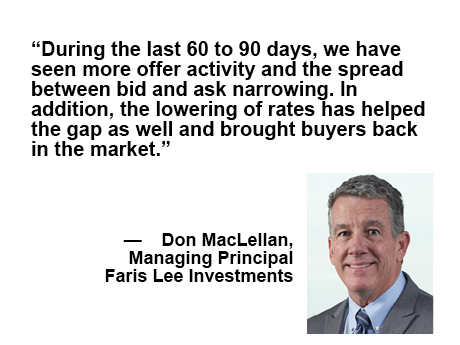Finding the ideal time to buy or sell a retail investment is next to impossible. This task seems to be made even harder as sellers long for the prices and demand of 2020 and 2021, while buyers wish for the interest rates associated with that time period.
But the past is the past. Retail investors can engage in shoulda, woulda, coulda until the cows come home, but it’s not a productive exercise. What is productive is operating with today’s fundamentals in mind.
Part of doing that, notes Shaun Riley, Jeff Conover and Don MacLellan of Faris Lee Investments, is knowing when to buy and sell. And the Irvine-Calif.-based managing principals say that time is upon us.

Faris Lee Investments
“There are some pretty compelling reasons to strike now when selling, rather than delay,” Riley says. “We are working with sellers showing them that cap rates have been positively impacted by the near-term lower interest rates and that retail fundamentals are still strong.”
Why Now Is the Right Time
Cap rates are one of the big reasons the managing partners believe there’s no time like the present to sell a retail investment.
“During the last 60 to 90 days, we have seen more offer activity and the spread between bid and ask narrowing,” MacLellan notes. “In addition, the lowering of rates has helped the gap as well and brought buyers back in the market.”
Conover notes that 5,000- to 15,000-square-foot strip centers continue to be attractive to buyers but at the same time quality of location and tenant mix is critical with buyers. Primary locations still command strong interest, but secondary/tertiary trade areas are seeing less offer activity and higher spreads in cap rates from primary sites.

Faris Lee Investments
“We know that developers are thinking, ‘Now that rates are coming down, if I have a buyer at a 5.5 cap, I can pass on them and find one at an even lower cap rate,’” Conover says. “We highly advise against this — because a bird in the hand is the better option. That other buyer may never show up.”
Cap rates aren’t the only thing that has risen, either.
Aside from higher costs, the waiting game can also result in vacancies — a less-than-ideal scenario for any prospective retail seller.
“There’s a few tenants facing bankruptcies right now,” Conover says. “If you own a property on that hitlist, it’s affecting the sale. You can’t move it.”
The managing partners point to Big Lots, Bed Bath & Beyond and drugstores as tenants that currently cause concern. The key in these cases is the quality of the real estate and if there are strong tenants that have backfilled these spaces.
Getting Deals Done Today
Saying you want to sell and successfully offloading an asset at a price one can live with are two very different things. The trio emphasizes, however, that there are plenty of success stories in today’s market — as long as sellers are willing to play by the current rules.
The first rule is ensuring your asset is priced correctly from the start.
“The critical lesson many sellers are learning right now is that they have to price it right,” Conover says. “You can’t chase the market. That becomes a lengthy process where you might never procure that buyer, resulting in a complete waste of time.”
Part of the reason pricing is so essential is the supply and demand imbalance.
“You have to price to sell in today’s market because there’s an oversupply and not as much 1031 demand as there was a few years back,” MacLellan adds. “That’s why high-level advisory is critical.”
Conover points to the amount of Starbucks on the market as an example of both oversupply and the need for appropriate advisory.
“There’s a lot more supply than demand,” he says. “There are more than 270 single-tenant, net-leased Starbucks on the market today. Where do you price that? In the middle of the pack? In a fluid market like this, you need advisors that can provide the most up-to-date intel possible to get you that shinier lure.”
Those worried about missing out on the high sale prices of yesteryear shouldn’t be too concerned about this priced-to-move strategy, Riley argues.
“For most retail product, there’s only about a 10 percent discount versus the very peak of the market two years ago,” he says. “Despite some of the headwinds sellers have been facing and a considerable amount of existing inventory for sale, we still feel this market is one where a seller can maximize investment dollars.”
One strategy the team is using to help sellers achieve their desired pricing is the short-term carry. Faris Lee recently executed this approach on the $12.9 million sale of Zecca Plaza, an Albertson’s-anchored neighborhood center in Gallup, N.M. The August acquisition provided the buyer with a 5.4 percent compound annual growth rate (CAGR) based on 3 percent annual rent increases for the majority of the center’s shop space, as well as the ability to increase current below-market rents.
MacLellan believes the deal wouldn’t have happened without the seller’s flexibility and open-mindedness in this current market.
“The market is challenging right now for bridge or short-term financing,” he explains. “But we were able to get the seller to understand that if they did a short-term carry, we could execute the deal and minimize volatility in this market.”
Breaking up an asset or offering a value-add opportunity are two more ways to get deals done, according to the team. The trio is also happy to report that activity has picked up in the second half of this year. Much of this is due to investors coming around on this market and sellers coming off the expected pricing of 2022 as well as the recent decline in interest rates.
“A Bird in the Hand”
“Our deal volume is 34 percent higher so far in the second half of this year, as opposed to the first two quarters,” MacLellan says. “There are so many reasons to sell that investors are ultimately saying, ‘Fine. I may not get 2022 pricing, but my internal business plan on the asset is not a long-term outlook. So, sell now and reallocate to my preferred asset class.’”
And the bigger picture, according to the team, is that retail is still a strong investment.
“People realize retail is a very favored asset class,” MacLellan continues. “You can sell a company and buy real estate. It’s a fixed-income commodity that’s proven to be a very stable, strong investment.”
— By Nellie Day. This article was written in conjunction with Irvine, Calif.-headquartered Faris Lee Investments, a content partner of Shopping Center Business.


